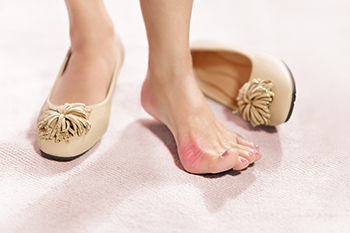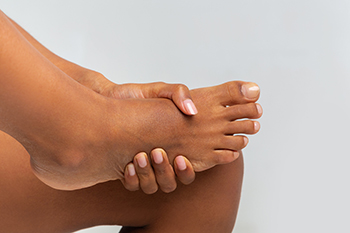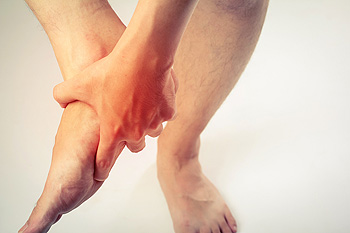August 2022
Reasons a Bunion Can Develop

A bump on the side of the big toe may be classified as a bunion. It can be large or small depending on how fast it develops. It may be uncomfortable and can happen as a result of wearing shoes that do not have adequate room for the toes to move around in. Some patients have pain in the bottom of their big toe that may gradually develop into the rest of the foot. In severe cases, the bunion may cause the other toes to shift and can result in overlapping. Many patients choose to have an X-ray taken and this can be beneficial in determining the extent of the deformity, in addition to observing if there is wear and tear on the joint. This condition may be the result of an abnormal foot structure and may happen to people who have flat feet. Additional reasons why people may develop a bunion can be from having endured a foot injury or possibly from collagen deficiency diseases. If you have a bunion, please confer with a podiatrist who can recommend what type of treatment is correct for you, and how to find permanent relief.
If you are suffering from bunions, contact one of our podiatrists of Family Foot Care. Our doctors can provide the care you need to keep you pain-free and on your feet.
What Is a Bunion?
A bunion is formed of swollen tissue or an enlargement of boney growth, usually located at the base joint of the toe that connects to the foot. The swelling occurs due to the bones in the big toe shifting inward, which impacts the other toes of the foot. This causes the area around the base of the big toe to become inflamed and painful.
Why Do Bunions Form?
Genetics – Susceptibility to bunions are often hereditary
Stress on the feet – Poorly fitted and uncomfortable footwear that places stress on feet, such as heels, can worsen existing bunions
How Are Bunions Diagnosed?
Doctors often perform two tests – blood tests and x-rays – when trying to diagnose bunions, especially in the early stages of development. Blood tests help determine if the foot pain is being caused by something else, such as arthritis, while x-rays provide a clear picture of your bone structure to your doctor.
How Are Bunions Treated?
- Refrain from wearing heels or similar shoes that cause discomfort
- Select wider shoes that can provide more comfort and reduce pain
- Anti-inflammatory and pain management drugs
- Orthotics or foot inserts
- Surgery
If you have any questions, please feel free to contact our offices located in Valatie and Albany, NY . We offer the newest diagnostic and treatment technologies for all your foot care needs.
Iselin Disease

Iselin disease is an overuse injury resulting from repetitive pressure or tension on the growth center at the base of the 5th metatarsal. Running and jumping can put a great amount of pressure on the forefoot. This disease affects children and usually resolves itself once the growth plate fuses, which generally occurs around age 12 for girls and 14 for boys. It cannot occur in adults because the growth plate closes over and turns into the bone with skeletal maturity at approximately 16 years of age. If your child has foot pain and you think it might be Iselin disease, consult with a podiatrist for proper management of discomfort associated with this condition. A pediatric immobilization brace may be used to offload the growth plate and allow for healing so that your child may maintain their activity level.
Some foot conditions may require additional professional care. If you have any concerns, contact one of our podiatrists of Family Foot Care. Our doctors can provide the care you need to keep you pain-free and on your feet.
Rare Foot Conditions
The majority of foot conditions are common and can be treated by a podiatrist. Standard diagnostic procedures are generally used to identify specific conditions and treatment can be rendered. A podiatrist also treats rare foot conditions which can be difficult to diagnose and may need extra attention and care.
There are many rare foot conditions that can affect children. Some of these can include:
- Freiberg’s disease
- Kohler’s disease
- Maffucci syndrome
Freiberg’s disease - This can be seen as a deterioration and flattening of a metatarsal bone that exists in the ball of the foot. It typically affects pre-teen and teenage girls, but can affect anyone at any age. Symptoms that can accompany this can be swelling, stiffness, and the patient may limp.
Kohler’s disease - This often targets the bone in the arch of the foot and affects younger boys. It can lead to an interruption of the blood supply which ultimately can lead to bone deterioration. The patient may limp or experience tenderness, swelling, and redness.
Maffucci syndrome - This affects the long bones in a child’s foot leading to the development of abnormal bone lesions. They are benign growths and typically develop in early childhood and the bones may be susceptible to breaking.
A podiatrist can properly diagnose and treat all types of rare foot conditions. If your child is affected by any of these symptoms or conditions, please don’t hesitate to call our office so the correct treatment method can begin.
If you have any questions please feel free to contact our offices located in Valatie and Albany, NY . We offer the newest diagnostic tools and technology to treat your foot and ankle needs.
Are You Suffering From Ingrown Toenails?
Facts About Sprained Ankles

Most sprained ankles occur when the ankle rolls outward as the foot twists inward. This causes the ligaments on the outside of the ankle to stretch and possibly tear. With a mild sprain, the ankle may be sore and stiff. It may swell slightly, but you should be able to walk with minor pain. As the severity of the sprain increases, your ankle may become bruised and tender, making walking far more painful. With a severe sprain, the ankle joint will feel unstable, and bearing weight is not possible. Ankle sprains can take a while to heal, but this long process is important to avoid re-spraining the ankle or developing chronic ankle problems. If you hear a popping sound at the time of the sprain, please see a podiatrist immediately. You will undergo an exam and be given a treatment schedule that may include pain medication, exercises, or bracing to protect the joint and allow it to heal properly. In some cases surgery may be required.
Ankle sprains are common but need immediate attention. If you need your feet checked, contact one of our podiatrists from Family Foot Care. Our doctors can provide the care you need to keep you pain-free and on your feet.
How Does an Ankle Sprain Occur?
Ankle sprains take place when the ligaments in your ankle are torn or stretched beyond their limits. There are multiple ways that the ankle can become injured, including twisting or rolling over onto your ankle, putting undue stress on it, or causing trauma to the ankle itself.
What Are the Symptoms?
- Mild to moderate bruising
- Limited mobility
- Swelling
- Discoloration of the skin (depending on severity)
Preventing a Sprain
- Wearing appropriate shoes for the occasion
- Stretching before exercises and sports
- Knowing your limits
Treatment of a Sprain
Treatment of a sprain depends on the severity. Many times, people are told to rest and remain off their feet completely, while others are given an air cast. If the sprain is very severe, surgery may be required.
If you have suffered an ankle sprain previously, you may want to consider additional support such as a brace and regular exercises to strengthen the ankle.
If you have any questions please feel free to contact our offices located in Valatie and Albany, NY . We offer the newest diagnostic and treatment technologies for all your foot and ankle needs.
When Plantar Warts Are Painful

Plantar warts are small patches of hardened growths that can form on the bottom, or sole, of someone’s feet. These warts are spread from one person to another through the human papillomavirus (HPV). Importantly, plantar warts are significantly different from corns, which form on the top of toes in response to friction or stress. Many cases of plantar warts may not cause the patient any pain. However, there are instances in which warts might be painful. If you have a larger plantar wart that essentially splits open, this could be a sign that pain might be felt later. This is because the tissue underneath a larger plantar wart can become irritated, which might ultimately result in bleeding and pain. Additionally, plantar warts can also cause the patient pain depending on where they are located. Warts that are situated on the skin folds of the toes can be especially painful. If a wart is growing inward, typically in response to the body putting pressure on the bottoms of feet when standing, then this can also be particularly painful. Contact a podiatrist for help with your plantar warts.
Plantar warts can be very uncomfortable. If you need your feet checked, contact one of our podiatrists from Family Foot Care. Our doctors will assist you with all of your foot and ankle needs.
About Plantar Warts
Plantar warts are the result of HPV, or human papillomavirus, getting into open wounds on the feet. They are mostly found on the heels or balls of the feet.
While plantar warts are generally harmless, those experiencing excessive pain or those suffering from diabetes or a compromised immune system require immediate medical care. Plantar warts are easily diagnosed, usually through scraping off a bit of rough skin or by getting a biopsy.
Symptoms
- Lesions on the bottom of your feet, usually rough and grainy
- Hard or thick callused spots
- Wart seeds, which are small clotted blood vessels that look like little black spots
- Pain, discomfort, or tenderness of your feet when walking or standing
Treatment
- Freezing
- Electric tool removal
- Laser Treatment
- Topical Creams (prescription only)
- Over-the-counter medications
To help prevent developing plantar warts, avoid walking barefoot over abrasive surfaces that can cause cuts or wounds for HPV to get into. Avoiding direct contact with other warts, as well as not picking or rubbing existing warts, can help prevent the further spread of plantar warts. However, if you think you have developed plantar warts, speak to your podiatrist. He or she can diagnose the warts on your feet and recommend the appropriate treatment options.
If you have any questions please feel free to contact our offices located in Valatie and Albany, NY . We offer the newest diagnostic and treatment technologies for all your foot and ankle needs.
Why Your Feet May Ache at Night

About 20 percent of people complain about foot pain at night, especially women, people over 50, and those who are overweight. Among the many possible causes are wearing high heels, standing for long periods at work, and nerve damage. Cramps and spasms may be the result of muscle fatigue, sitting for long periods, or wearing tight shoes. Chemical changes in the body during pregnancy can also cause cramping. A number of foot-related conditions may also result in nighttime foot pain. Among them are Morton’s neuroma, plantar fasciitis, fibromyalgia, and peripheral neuropathy. Diabetes can also be a major source of foot pain, as reduced blood circulation can cause muscle pain in the feet. The first and easiest remedy for recurring foot pain is to check your footwear. Find shoes that cushion the feet and offer ample room for the toes. There are a number of exercises, as well as certain medications, that can help reduce foot pain. If your nighttime foot pain worsens, please consult a podiatrist as soon as possible. They can conduct a complete exam to determine the cause and offer the appropriate treatment plan.
Foot Pain
Foot pain can be extremely painful and debilitating. If you have a foot pain, consult with one of our podiatrists from Family Foot Care. Our doctors will assess your condition and provide you with quality foot and ankle treatment.
Causes
Foot pain is a very broad condition that could be caused by one or more ailments. The most common include:
- Bunions
- Hammertoes
- Plantar Fasciitis
- Bone Spurs
- Corns
- Tarsal Tunnel Syndrome
- Ingrown Toenails
- Arthritis (such as Gout, Rheumatoid, and Osteoarthritis)
- Flat Feet
- Injury (from stress fractures, broken toe, foot, ankle, Achilles tendon ruptures, and sprains)
- And more
Diagnosis
To figure out the cause of foot pain, podiatrists utilize several different methods. This can range from simple visual inspections and sensation tests to X-rays and MRI scans. Prior medical history, family medical history, and any recent physical traumatic events will all be taken into consideration for a proper diagnosis.
Treatment
Treatment depends upon the cause of the foot pain. Whether it is resting, staying off the foot, or having surgery; podiatrists have a number of treatment options available for foot pain.
If you have any questions, please feel free to contact our offices located in Valatie and Albany, NY . We offer the newest diagnostic and treatment technologies for all your foot care needs.




